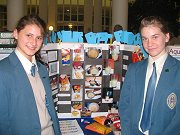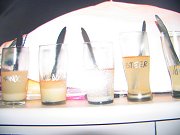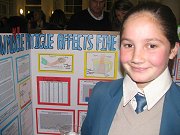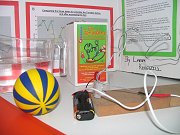
School science projects shouldn't be scoffed at – this much was recently proven in New Zealand, where a high school science experiment by two 14-year-old learners managed to embarrass one of the world's largest food and pharmaceutical companies.
According to The New Zealand Herald (24 March 2007), the two learners found that Ribena, a popular drink manufactured by GlaxoSmithKline, had a much lower level of vitamin C than was claimed in advertisements.
The consumer affairs show Fair Go heard of the experiment and the students' futile attempts to get a response from the company. As a result, the Commerce Commission reacted, and GlaxoSmithKline now faces charges with regards to 15 breaches of the Fair Trading Act.
Closer to home, Cape Town learners have also proven that they're a force to be reckoned with. Grade 9 learners at Herschel Girls' School in Claremont were recently involved in creating one of the best science exhibitions the school has ever seen. Many of them outlined useful health tips.
"The learners have managed to come up with a number of useful things this year," commented Don Gibbon, teacher and exhibition co-ordinator, shortly before the school's award ceremony on 10 May.
The learners will be participating in the Eskom Expo for Young Scientists National Finals, which will take place on 28 and 29 September in Pretoria. Before this, however, Herschel's top twelve projects will be competing with many others at the Cape Town Region Expo at the MTN Science Centre in Canal Walk from 14 to 16 August.
We caught up with a few of the budding scientists:
"Pack-a-shack" (Herschel's top project for 2007) By Sarah Mason
Herschel learner Sarah Mason couldn't ignore the dire circumstances of those living in informal settlements off the N2 near Cape Town International Airport. She decided to take action – and came up with an idea that awarded her the first prize in the school's in-house competition.
|
|
|
The aim of Sarah's "Pack-a-shack" project was to design and package a marketable, affordable, durable and comfortable shack with suitable materials.
During her research, Sarah did all sorts of tests on "mini" shacks, which she manufactured herself. These tests included making a fire in the shacks to test their flammability, placing them in direct sunlight to test their heat resistance, and submerging them in water to check for water resistance.
"She put in a tremendous amount of work," says teacher Don Gibbon, who was most impressed by her project.
The long hours paid off. Sarah found that the best materials for building a shack were corrugated zinc and Nutech board. These materials were reasonably water and fire resistant, and they provided sufficient insulation against both high and low temperatures.
What's in our fast-food chips?
By Aimee Fanton and Amelia Vernede
Chips certainly aren't ideal fare. But let's be realistic: most of us eat them every once in a while. So which fast-food franchises serve the healthiest chips?
|
|
|
Aimee and Amelia managed to demonstrate that all chips aren't created equal. They went out on a fast-food hunt, bought packets of chips from five popular take-away outlets (Steers, Nando's, KFC, McDonald's and Wimpy) and returned home to put their samples to the test.
First, they put each separate serving in boiling water for 20 minutes. Then they put the residual water from each in a glass, after which they stored each glass in the freezer for 80 minutes.
They knew that, upon removal, each glass would have formed three separate layers: a fat layer at the top, a watery layer in the middle, and a starchy layer at the bottom. Now, measuring the amount of fat and starch present in the chips was simple. According to the young scientists, the chips from Nando's and Steers turned out to be the healthiest.
Which nappy dominates?
By Jade Hubner and Olivia de Klerk
"Which nappy has the most absorbent capacity and absorbent retention?" This is a question many a desperate mother has asked herself and one that two Herschel learners set out to answer.
|
|
|
Jade and Olivia used a saline solution to test the absorbent power of three different nappy brands – Huggies, Pampers and Cuddlers. They first weighed the nappies' dry weight, after which they soaked them in the saline solution. They then lifted them out, allowed them to drip for 2 minutes, and then weighed them again.
Good news for Huggies: they found that these nappies absorbed the most liquid.
How muscle fatigue affects fine motor control
By Lara Kingwell
Lara was interested to know whether the increase of muscle fatigue and the build-up of lactic acid in the muscles of the hand will decrease the hand's fine motor control.
|
|
|
Testing it on a few willing family members, Lara used a small ball and a "trembler" to test whether this was indeed true. Each volunteer had to move a ring-shaped wire along another piece of curved wire (a device called "the trembler", which registers when you accidentally touch the curved wire with the ring) before and after squeezing a ball – an action which causes muscle fatigue.
"My results show that muscle fatigue in the hand decreases fine motor control," Lara wrote on her project poster.
Commenting on her work, Dr Ross Tucker from the Sports Science Institute noted that Lara's experiment could maybe help those who take part in sports that require fine motor control (e.g. shooting and archery) to analyse their muscle fitness and abilities.
(Carine van Rooyen, May 2007)




 Publications
Publications
 Partners
Partners





















